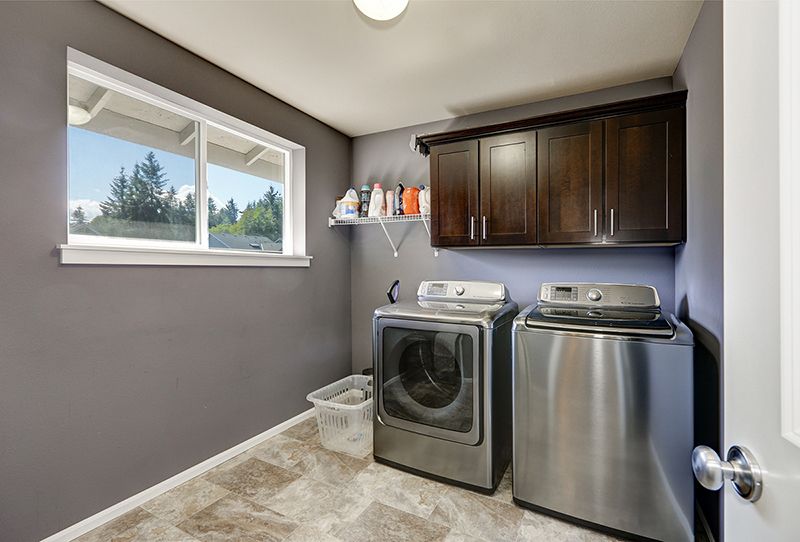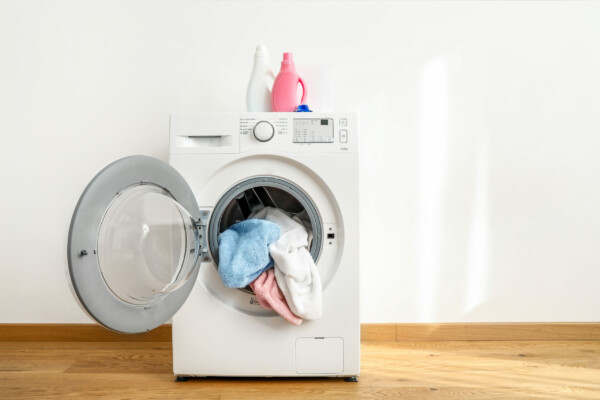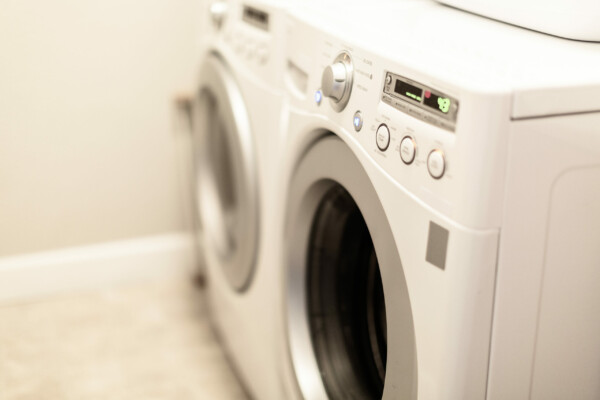A Comprehensive Comparison: Electric Dryers vs. Gas Dryers
In this article…
- Operation
- Appliance Cost
- Installation Process
- Energy Consumption Costs
- Drying Time
- Safety & Fire Risk
- Durability
- Environmental Considerations
- Smart Use Tips
- The Final Verdict
- Do You Have Issues With Your Home Appliances?
Whether you love it or hate it, doing the laundry is one of those chores you can’t avoid. So, if you’re in the market for your first dryer or considering an upgrade, it’s time to evaluate what’s available thoroughly.
As you might imagine, new machines are more energy-efficient than ever before. They’re available in high-capacity sizes, including intuitive smart features and special functions, plus they come in various attractive designs and styles. You can be sure that your new dryer will be very different from the one your mother owned.
Interestingly, there is one similarity to those old-style workhorses; they are still available in electric and gas.
You may be inclined to purchase the type your family used because of familiarity or comfort level, but buying a clothes dryer is an investment that will impact your family for years. Take this opportunity to understand each type’s pros and cons before deciding.
This is what you need to know:
When comparing electric dryers to gas dryers, both are equally effective at drying laundry, with no clear advantage to either power source. However, they differ in various aspects such as operation, cost, energy efficiency, installation requirements, drying duration, safety considerations (including fire risk), as well as durability and maintenance needs. Although electric dryers are often less expensive initially and quicker to install, their ongoing operating costs increase over time as a result of rising electricity prices. Gas dryers may have a higher initial cost and require professional installation for a gas line, but they tend to be more energy-efficient and cost-effective in the long run, especially if you have access to affordable natural gas. To determine which option is ideal for you, take into account your long-term usage, energy availability, and budget.
Operation
The act of drying clothing is actually quite scientific, so both electric and gas dryers work in a similar fashion:
As air enters the dryer, it traverses a heating coil, warming it up. An electric fan then distributes this heat throughout the dryer, ensuring that the clothes are continuously heated while tumbling. As a result of this process, molecules from the water within the garments heat up and transform into steam through evaporation. The steam is subsequently expelled from the machine via the dryer’s exhaust tube.
Electric dryers are powered by a 240-volt current, which is twice the power typically required for most household appliances, to operate the electric heating coils and motors.
On the other hand, gas dryers utilise natural gas or propane, in addition to electricity, for operation. A burner converts the gas into heat via a dedicated gas line, while a 120-volt electrical outlet supplies power to the drum and blower motors.
Appliance Cost
According to Consumer Reports, depending on features, electric dryers generally cost between $500 and $1,400. Gas dryers can run between $50 and $150 more than the comparable electric model.
Must-have features available on both types will be contributing factors to how much you spend:
- Moisture Sensor—this is a huge improvement over thermostats in previous models. This detects how much moisture remains in the dryer and automatically turns off the machine when the laundry is dry. This feature not only helps in minimising shrinkage but also prolongs the lifespan of your garments by preventing excessive drying, all while conserving energy.
- Extended Tumble—how often have you forgotten to remove your clothes from the dryer only to find them a wrinkled mess? This innovative feature intermittently rotates the clothing for up to three hours after the cycle ends, sparing you the hassle of ironing.
- End-of-Cycle Signal—even if you don’t have the extended tumble feature on your new dryer, you can be alerted when your clothing is dry with a series of beeps or chimes. When the dryer stops, removing your clothes promptly will save ironing time or alert you to clothes that need additional drying time. There is no fear of disturbing the baby as most signals have a volume or on/off switch.
- Capacity Size—it’s very important to “pair” your dryer with your washer, or you won’t be able to fit a full washer load into one cycle. The general rule is your dryer should hold twice the capacity of your washer. If they are too small, there won’t be enough room to tumble or dry the clothes efficiently.
Compact units for those with limited space or light laundry needs are available at 3.4 cu. Ft. “Full-size” dryers are most common and range between 5.8 cu. Ft. and 8.3 cu. Ft. “Mega-capacity” units can handle heavy-duty loads and come as large as 9.0 cu. Ft. Be careful searching only by dryer terminology, as manufacturers don’t always identify their units the same.
Installation Process
Electric dryers are pretty easy to install as most laundry areas have a dedicated 240-volt circuit. Many models don’t require venting either, making them a perfect choice for an apartment or home with limited space. Be careful that your electric model has some lint catcher, or you’ll find lint and dust strewn all over your laundry room.
Gas dryers pose a greater complexity and demand extra space. Apart from a 120-volt electrical outlet, they necessitate a distinct gas connection. If you lack this setup, it’s advisable to enlist the services of a certified Gas Fitter Technician to ensure compliance with safety standards. Furthermore, all gas dryers mandate external venting to expel hazardous emissions.
Plan about $100 for a simple installation or several hundred dollars to hire out a gas line and vent system.
Energy Consumption Costs
As the second least energy-efficient appliance in your home (only the refrigerator tops it,) dryers make up approximately 10 percent of all energy costs. As we identified earlier, electric dryers are less expensive for the initial purchase, but those savings may be eaten up by electricity costs and the length of time needed to run the machine.
While gas dryers may entail a higher initial cost, their efficiency, even with the incorporation of a gas line and vent system, could make them the more cost–effective option in the long run. Gas prices typically tend to be lower than electricity, and their quicker drying times might render a gas dryer the most economical choice over its lifespan.
Irrespective of your preferred power source, ensure that it is Energy-Star certified to access the most efficient features available. Highlighting their efficiency with claims such as being “20 percent more efficient than standard models,” both Energy Star electric and gas dryers are equipped with moisture sensors to reduce drying times and lower heat settings to minimise power consumption. These attributes can enhance efficiency and reduce operational expenses.
Drying Time
Both gas and electric units with comparable features will dry clothing in about the same amount of time. However, gas models heat up faster, so they have the edge for speed over electric dryers.
Another crucial consideration is whether the appliance is vented or non-vented. Gas dryers necessitate venting to prevent the accumulation of harmful fumes, whereas electric models come in vented and non-vented variants. Vent-less units typically utilise a condenser to heat the air, which then evaporates the water, drains into a chamber, and is reheated to initiate the cycle anew. While this approach eliminates the requirement for outdoor exhaust, it may result in slower drying times.
Safety & Fire Risk
We’ve talked about the toxic fumes that can build up on gas dryers, but now it’s time to identify the real risk factors associated with poor ventilation for your dryer.
- Building regulations may pose constraints—certain local ordinances forbid the operation of dryers without an external venting system. The concern with gas dryers is the possibility of carbon monoxide build-up, especially in a confined area. This colourless, odourless gas can cause dizziness, dull headache, weakness, nausea, vomiting, confusion, blurred vision, shortness of breath, loss of consciousness or death.
- Humidity—approximately two litres of water evaporates from every load of laundry. If you allow that water vapour to be released back into your room (as is the case with some electric dryers), the humidity will rise, and the excessive moisture in the air can lead to mould and mildew. Approximately 10 to 20 percent of the world’s population is allergic to mould. Reactions range from congestion and wheezing to red eyes or skin rashes. Prolonged exposure may result in symptoms such as dizziness, fever, breathlessness, or flu-like sensations. They’ve also been known to cause attacks for people suffering from asthma. You can run a dehumidifier in your laundry area to reduce some of the extra moisture in the room but keep in mind the extra electricity that will be used to run it.
- Lint—this seems harmless enough, especially when just a few pieces are stuck on your clothing. Unfortunately, lint accumulation in your dryer or dissipation around your room can be hazardous. A U.S. A report from the Consumer Product Safety Commission (CPSC) highlights that the majority of dryer fires stem from the accumulation of highly flammable lint. Electric dryers pose a greater fire risk than gas as they produce more heat. This is a significant concern, with more than 15,000 fires causing injury, death, and millions in property damage. Ensure to clean out the lint filter after every load and annually clear out the lint from the exhaust pipe to the outside.
Durability
Numerous common problems are reported with gas and electric dryers, so it’s difficult to determine a clear winner in this category. FIX Appliances CA offers affordable, same-day service, so you’ll be up and running quickly.
Common Symptoms and Problems:
- Too Noisy—bearings, seals or worn belts.
- Won’t Start—heating element, high-limit thermostat or cycling thermostat.
- Little or No Heat—heating elements or fuses.
- Drum Won’t Tumble—switches or belts.
- Broken Timer—timer motors or cycling thermostats.
- Slow Drying—heating elements, thermostats or coils.
- Won’t Shut Off—door switches or timers.
- Shuts Off Too Soon—fuses, heating coils or thermostats.
- Too Hot—fuses or thermostats.
Environmental Considerations
While the most environmentally friendly method of drying clothes is to hang them outside to air dry, the convenience and practicality of using a dryer make this the most popular option today.
Investing in an Energy-Star certified appliance, equipped with eco-friendly features, can enhance efficiency and aid in conserving energy. Moreover, utilising renewable energy sources such as wind or solar power can further contribute to environmental preservation.
Smart Use Tips
To optimise energy efficiency and cost-effectiveness, both gas and electric dryers can benefit from implementing the following smart usage tips recommended by the Consumer Energy Centre:
- Heat the room—the dryer must work harder to maintain the proper temperature for drying clothes, so you must use it in a heated space.
- Clean the filter—as mentioned above, cleaning the lint filter regularly will help reduce fire risk. In addition, a clean filter will help with airflow and allow the clothes to dry faster.
- Dryer sheets can leave a residue on the lint filter, therefore, if you frequently use them, it’s advisable to clean the filter monthly using a toothbrush.
- Don’t overload—having a full load for your dryer to work perfectly is important. Always remember that overloading will take more time to dry the entire load and reduce the life of the clothes.
- Check the outside dryer vent—this should be done occasionally to ensure there are no outside air leaks and that it is free from lint build-up.
- Sort your laundry by type—aim to dry garments of similar fabrics together. When you mix heavy denim jeans with a lightweight synthetic, your clothing will take longer to dry.
- Dry several loads consecutively—it takes less time to heat up the dryer after it’s already been running, so be sure to dry several loads one after the other.
- Use the moisture sensor—this new feature automatically shuts the machine down once the clothes are dry.
The Final Verdict
Now that you understand the pros and cons of gas and electric dryers, you can decide which type will work best for you. Gas is more budget-friendly than electricity overall, but the extra cost of the machine and installation of a gas line may limit the savings.
Follow the tips for using your machine properly, and you’ll not only save energy, but you’ll also save money.
Whenever you have a question about the proper use of your machine or if you need service for an appliance breakdown, including squeaky dryer issues or appliance installers, contact FIX Appliances CA. Our skilled technicians are available for immediate service whenever you need them, and every dryer repair is covered by a service and parts warranty for your peace of mind.
Do You Have Issues With Your Home Appliances?
Our repair specialists will correctly diagnose and repair your equipment. We have improved our service, and we have an emergency service for Samsung, Bosch, LG, Blomberg, Whirlpool or Maytag dryer repair. And also, a service for household home appliance repair service on the same day is available.
Date of page creation: December 07, 2021
Page update date: April 09, 2024
Ask a Question




